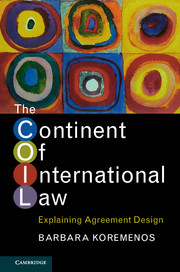Book contents
- Frontmatter
- Dedication
- Contents
- List of figures
- List of tables
- Acknowledgments
- 1 (Re)discovering the continent
- Part I COIL's building blocks: theory and data
- Part II Flexibility provisions in the design of international law
- 4 Duration provisions
- 5 Escape clauses and withdrawal clauses
- 6 (Im)precision and reservations
- Part III Centralization, scope, and control provisions in the design of international law
- Appendix 1 List of agreements in COIL sample
- Appendix 2 Coding rules
- Appendix 3 Selection issues in international cooperation data sets
- References
- Index
4 - Duration provisions
from Part II - Flexibility provisions in the design of international law
Published online by Cambridge University Press: 05 June 2016
- Frontmatter
- Dedication
- Contents
- List of figures
- List of tables
- Acknowledgments
- 1 (Re)discovering the continent
- Part I COIL's building blocks: theory and data
- Part II Flexibility provisions in the design of international law
- 4 Duration provisions
- 5 Escape clauses and withdrawal clauses
- 6 (Im)precision and reservations
- Part III Centralization, scope, and control provisions in the design of international law
- Appendix 1 List of agreements in COIL sample
- Appendix 2 Coding rules
- Appendix 3 Selection issues in international cooperation data sets
- References
- Index
Summary
We all know that future generations will have to live, even on a strictly technological level, in a setting very different from the present one. To imprison them in an iron corset, which could not be adjusted to the changing conditions of history, would in our opinion expose that corset to the danger of bursting. We therefore prefer a steel corset which, being more flexible, could more effectively assure the continuation of the treaty.
(Statement issued by Italian Representative Caracciolo with regard to the proposed Nuclear Non-Proliferation Treaty)Looking at the COIL random sample, 60 percent of the agreements are characterized by a finite duration. While economic agreements are significantly more likely to be of finite duration than human rights agreements, almost 30 percent of human rights agreements are explicitly not indefinite. These statistics contradict the conventional wisdom regarding hands tying as the surest means to a credible commitment.
Furthermore, Article 54 (b) of the VCLT stipulates that a treaty can end at any time if all of the parties agree to the termination. Why then would over half of the agreements in the sample stipulate a particular end date?
The answer can be found in the politics of international law. International law often has non-trivial distributional consequences; that is, there are winners and losers. At the time a treaty enters into force, member states expect they will benefit; otherwise, they would not join. However, the distributional consequences of a new agreement may not be known with certainty at the time the agreement is first negotiated. For example, if an agreement establishes a new institution or a new pattern of trade, the effect of this innovation on the GNP or on the security of each of the parties to the agreement may be known only approximately in advance. States will not want to tie their hands indefinitely until they determine how the agreement actually works in practice. Thus, while all states initially believe they will benefit, after some time, some states may conclude that membership in the agreement generates a net loss (or at least a smaller gain than some different arrangement). Alternatively, over time, there may be shocks to the distribution of benefits, with the result that some states find themselves to be relative winners while others find themselves to be relative losers.
- Type
- Chapter
- Information
- The Continent of International LawExplaining Agreement Design, pp. 103 - 123Publisher: Cambridge University PressPrint publication year: 2016



